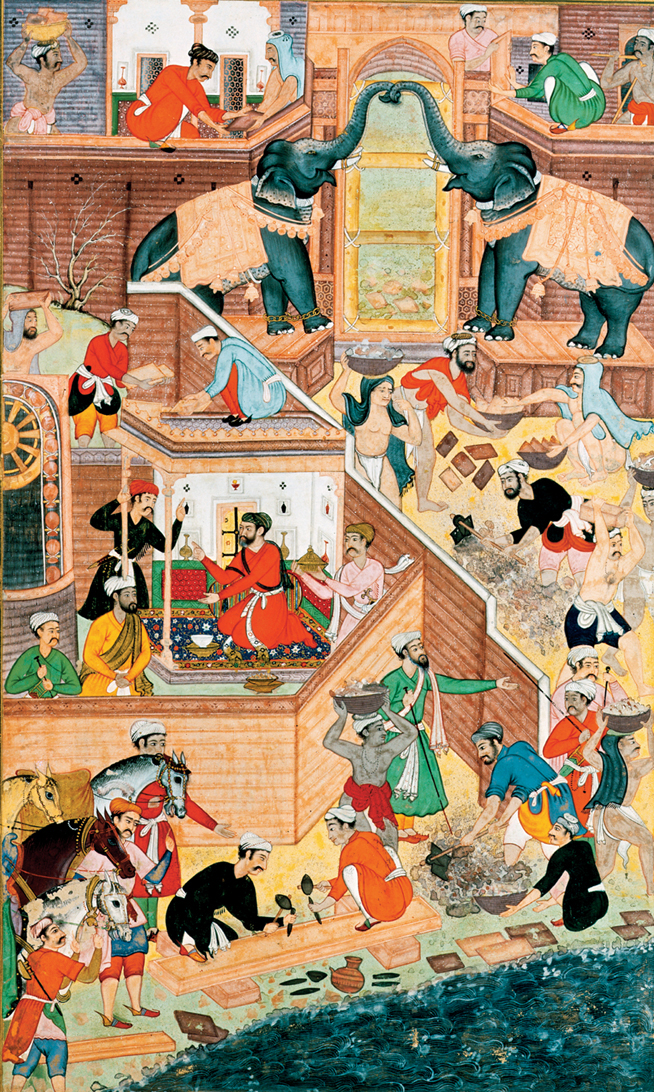Non-Muslims Under Muslim Rule
How did Christians, Jews, Hindus, and other non-Muslims fare under these Islamic states?
Drawing on Qur’anic teachings, Muslims had long practiced a religious tolerance unknown in Christian Europe. Muslim rulers for the most part guaranteed the lives and property of Christians and Jews on their promise of obedience and the payment of a poll tax. In the case of the Ottomans, this tolerance was extended not only to the Christians and Jews who had been living under Muslim rule for centuries but also to the Serbs, Bosnians, Croats, and other Orthodox Christians in the newly conquered Balkans. The Ottoman conqueror of Constantinople, Mehmet, nominated the Greek patriarch as official representative of the Greek population. This and other such appointments recognized non-Muslims as functioning parts of the Ottoman society and economy. In 1454 Rabbi Isaac Sarfati sent a letter to the Jews in the Rhineland, Swabia, Moravia, and Hungary, urging them to move to Turkey because of the good conditions for Jews there. A massive migration to Ottoman lands followed. When Ferdinand and Isabella of Spain expelled the Jews in 1492 and later, many immigrated to the Ottoman Empire.
The Safavid authorities made efforts to convert Armenian Christians in the Caucasus, and many seem to have embraced Islam, some more voluntarily than others. Nevertheless, the Armenian Christian Church retained its vitality, and under the Safavids Armenian Christians were prominent merchants in long-distance trade (see “Merchant Networks in the Islamic Empires”).

Emperor Akbar in the City of Fatehpur Sikri In 1569 Akbar founded the city of Fatehpur Sikri (the City of Victory) to honor the Muslim holy man Sheik Salim Chishti, who had foretold the birth of Akbar’s son and heir Jahangir. Akbar is shown here seated on the cushion in the center overseeing the construction of the city. The image is contained in the Akbarnama, a book of illustrations Akbar commissioned to officially chronicle his reign. (Victoria & Albert Museum, London, UK/The Bridgeman Art Library)
Babur and his successors acquired even more non-Muslim subjects with their conquests in India, which included not only Hindus but also substantial numbers of Jains, Zoroastrians, Christians, and Sikhs. Over time, the number of Indians who converted to Islam increased, but the Mughal rulers did not force conversion. When the first reliable census was taken in 1901, the Ganges plain, the area of the Indian subcontinent most intensely exposed to Mughal rule and for the longest span of time, had a Muslim population of only 10 to 15 percent. Accordingly, some scholars have argued that in the Indian subcontinent there was an inverse relationship between the degree of Muslim political penetration and conversion to Islam.
Akbar went the furthest in promoting Muslim-Hindu accommodation. He celebrated important Hindu festivals, such as Diwali, the festival of lights, and he wore his uncut hair in a turban as a concession to Indian practice. Also, Akbar twice married Hindu princesses, one of whom became the mother of his heir, Jahangir, and he appointed the Spanish Jesuit Antonio Monserrate (1536–1600) as tutor to his second son, Prince Murad. Eventually, Hindus totaled 30 percent of the imperial bureaucracy. In 1579 Akbar abolished the jizya, the poll tax on non-Muslims that guaranteed their protection. These actions, especially the abolition of the jizya, infuriated the ulama, and serious conflict erupted between its members and the emperor. Ultimately, Akbar issued an imperial decree declaring that the Mughal emperor had supreme authority, even above the ulama, in all religious matters, to the dismay of the Muslim religious establishment.
Some of Akbar’s successors, above all Aurangzeb, sided more with the ulama. Aurangzeb appointed censors of public morals in important cities to enforce Islamic laws against gambling, prostitution, drinking, and the use of narcotics. He forbade sati — the self-immolation of widows on their husbands’ funeral pyres — and the castration of boys to be sold as eunuchs. He also abolished all taxes not authorized by Islamic law. To compensate for the loss of revenue, in 1679 Aurangzeb reimposed the tax on non-Muslims. Aurangzeb’s reversal of Akbar’s religious tolerance and cultural cosmopolitanism extended further. He ordered the destruction of some Hindu temples and tried to curb Sikhism. He also required Hindus to pay higher customs duties than Muslims. Out of fidelity to Islamic law, he even criticized his mother’s tomb, the Taj Mahal: “The lawfulness of a solid construction over a grave is doubtful, and there can be no doubt about the extravagance involved.”4 Aurangzeb’s attempts to enforce rigid Islamic norms proved highly unpopular and aroused resistance that weakened Mughal rule. Aurangzeb himself died on an unsuccessful military campaign in 1707 to suppress a rebellion by the Marathas in the southern highlands.
